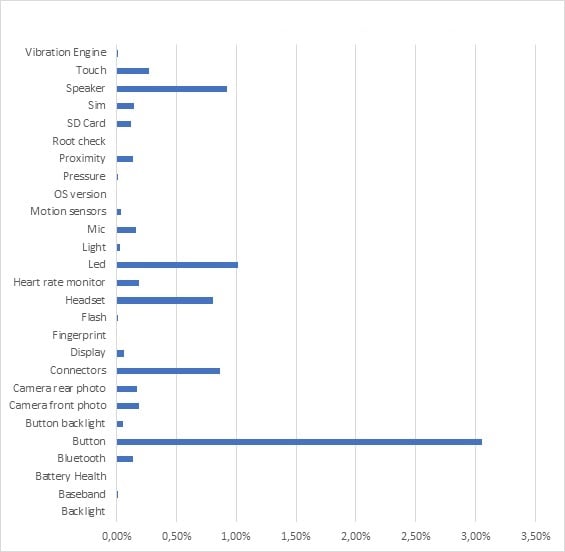
Blogs
Experiences from the reverse logistics of smartphones
Is it safe to buy a refurbished smartphone? This is one of the most common questions written to Google when a consumer is considering buying a used smartphone. “Are they any good?” “Will they function well?” “Can I trust that it works?” The answer is a resounding “Yes,” if you ask OptoFidelity. “Based on our experience from the reverse logistics of smartphones, the quality of second-hand phones for sale is excellent, especially if you buy them from established suppliers in the business,” Hans Kuosmanen, SVP from OptoFidelity, confirms.
OptoFidelity is a well-known automated testing solution provider for smartphone manufacturers, providing various smartphone test solutions for more than ten years. Likewise, OptoFidelity is as experienced in the reverse logistics of smartphones, partnering with leading companies in the business, such as FutureDial. OptoFidelity™ Fusion has already been in operational use in reverse logistics of smartphones for two years. The test solution automatically recognises over 100 different smartphone models from most of the globally known brands.
More and more consumers are considering buying a second-hand phone. The price tag for a brand new phone might be just out of reach. Or imagine having a kid who might want a phone with great features, but there´s a considerable amount of risk of damaging and scratching the phone soon after purchase. For many consumers, there is no need, not enough money and no interest to pay the premium prices. In addition, the telecom business models operate in a similar direction. A premium subscription could include a new phone which is then renewed annually. There is a constant source of class A premium second-hand phones available.
Recent numbers and industry news are backing up the story. Samsung, AT&T, Verizon, Sprint, T-Mobile, Best Buy, Amazon and Ebay, among other well-known brands, are operating in the business.
Additionally, the recent numbers show that the billion-dollar business continues to grow. According to Counter-Point Market Research the volumes in refurbishment of smartphones in 2017 reached 140M units globally, y/y growth being 13%. This is an interesting number, especially when you consider the news from the smartphone industry where total sales is declining 3% annually. You can also ask yourself whether this change in consumer behaviour has anything to do with the latest news from Apple.
So what is the risk of buying a useless or at least somewhat malfunctioning smartphone when buying a second-hand phone?
“The risk is very low,” SVP Hans Kuosmanen from OptoFidelity comments. “First of all, if you buy the phone from an established supplier, you can trust them. They are testing and repairing the phones, if needed, before putting them on sale. We have been working with quite a number of them, and they do take the issue of quality very seriously.”
Thomas Rayas, FutureDial’s SVP, confirms this fact. “Our customers include most of the tier 1 mobile operators in North America and their 3PL partners, as well as established players in the smartphone logistics and repair business across Asia and Europe. By leveraging the automation solutions from FutureDial and OptoFidelity, phone quality is reaching similar levels to what consumers expect from new devices. We have proven a test accuracy of over 95% to our customers. This means that consumers can expect to see less than 5% of the phones sold on the secondary markets to malfunction.”
Sample data backs up the story of a safe buy
What are then the faults which are common for second-hand phones? Typically, the most common failure is the screen. This may include a faulty or damaged touch screen. And this type of fault is always fixed before the phone is accepted to be ready for resale.
An operative data example from the refurbishing process backs up the story of OptoFidelity and FutureDial Inc. In the sample data below, you can see typical failures reported during the testing process, in which we took test results from 1 million test cases. All and all, these close to 1M test cases failed 2,200 times.

Functional faults from OptoFidelity data. Sample size for each test case might vary. Close to 1M test cases executed.
The first thing that you can see from the numbers is that the phones arriving at a refurbishing plant are of very good quality. The distribution of failures can be seen in the image above. The sample data suggests that the home button might be the most failure-prone component in this sample. In general, you can make an estimation from the data that no more that 3-4% of the incoming phones have functional failures. With OptoFidelity and FutureDial technology we can catch 95% of these failures. This means that, with our testing solutions, less than 0.5% of phones have failures.
What can we conclude from the experience?
Reverse logistics of smartphones just makes sense. Second-hand phones are a safe buy, especially if you buy them from an established second-hand retailer. They are cheaper and the likelihood of buying a malfunctioning phone is almost as small as when buying a new one. The best deals even include a warranty for a few months. “I would consider buying a second-hand phone myself,” Hans Kuosmanen, comments. “And I´m sure that a good-quality second-hand phone would make a lot of sense in business use, where the actual features, not the manufacturing year, matter.”
One important value in the refurbishment of smartphones, is the fact that its doing really good for environment. Effective reverse logistics of smartphones is an example of real life recycling business, which is just good for everyone. Value for consumer, environmental aspects for society and business opportunity for others.
Written by


